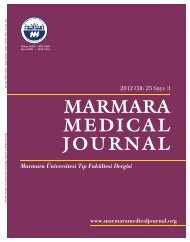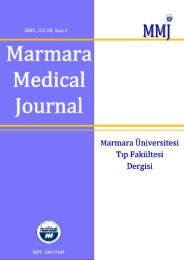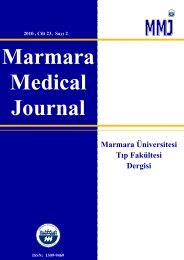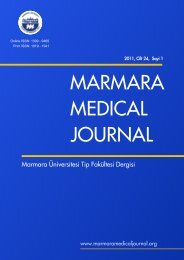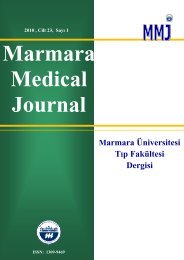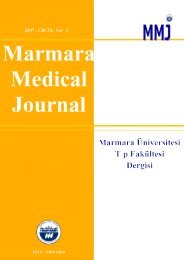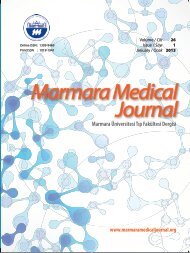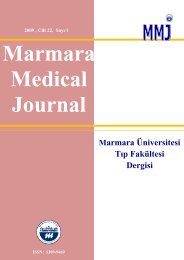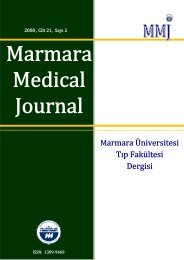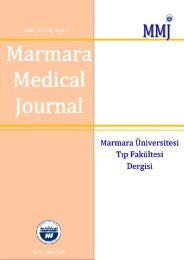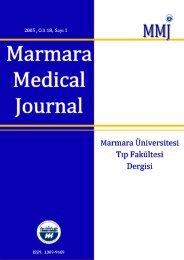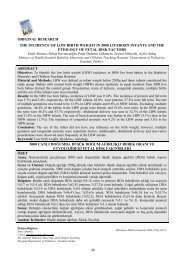Tam Metin PDF (4158 KB) - Marmara Medical Journal
Tam Metin PDF (4158 KB) - Marmara Medical Journal
Tam Metin PDF (4158 KB) - Marmara Medical Journal
- No tags were found...
You also want an ePaper? Increase the reach of your titles
YUMPU automatically turns print PDFs into web optimized ePapers that Google loves.
Melih AKINCI et alTuba-ovarian inguinal herniationthe ovary. Indeed female patients especially youngones have a high incidence of injury to the ovaryand fallopian tube that had herniotomy in the handsof unwary surgeons 8 . However, the patient of thiscase report was 34 years old at her left hernia repairand she had only painless groin lump till to the timeof percutaneous sclerotherapic drainage. Besidesshe had a history of right inguinal hernia 14 yearsago and normal vaginal births 7 and 14 years agothat she had been controlled several times andgynecologic ultrasonography at least two times hadbeen performed seven years ago.Without dispute the most commonabnormality in the groin is a hernia, which containsbowel loops, omental fat, and peritoneal fluid.Routine ultrasound had been advised to discoverthe contents of the hernia sacs before performingherniotomy especially on children in order todecrease the risk of injury to these organs 8 . In thiscase ultrasound revealed no vascular activity, nocommunication with the peritoneum and noperistaltic activity was observed. The possiblediagnosis from the ultrasound findings included fluidin a relapsed inguinal hernia or a lymphocele, or asterile collection of fluid associated with a pastinflammatory episode. Indeed there are variouscystic masses involving the female groin, such asround ligament cysts, varicosities of the roundligament, inguinal herniation of the ovary, cysticlymphangiomas, epidermal inclusion cysts,abscesses, and pseudoaneurysms so thatsonography is helpful for the differential diagnosis ofthe pathologic spectrum of cystic masses involvingthe female groin 9 . Ultrasound is a cheap and easy toperform complementary radiological exam toconfirm the cystic nature of the lesion. Therefore, weused the sonography as the first step to evaluatethe groin lump and follow up of the cystic lesion.After all discussion, we agree that the mostprobable diagnosis of this case was a lymphocele.This diagnosis was supported with age, previousherniorrhaphy history, normal leukocyte count,cystic ultrasonograhic image, negative cultures andconsistent cytology examination of aspirated cysticfluid. A lymphocele, also known as a lymphocyst, isa collection of lymphatic fluid occurring as aconsequence of surgical dissection and inadequateclosure of afferent lymphatic vessels. Generallypelvic lymphocele has been described that iscaused by lymphatic injury usually secondary topelvic lymphadenectomy and renal transplantation.Trauma is also a factor for formation of lymphocelefor all localizations but in literature there have beenfew reports of lymphocele which was primary as apelvic one in a pregnant woman 10 and the other onewas cervical localization 11 . However, in the presentcase, no etiologic factor was apparent except thesame sided groin hernia repair twelve years ago. Toour literature search, this is the first reported case ofprimary groin lymphocele or late complication ofgroin hernia repair as a lymphocele.Lymphoceles can cause morbidity andrarely mortality by compression of adjacentstructures and infectious complications. Treatmentalternatives for lymphoceles include surgicalmarsupialization by open or laparoscopic surgery orpercutaneous catheter drainage. Selection oftreatment method currently depends on institutionalpreferences 10 . Open surgery and peritonealmarsupialization can be used for the treatment oflymphoceles with good success rates; however,long hospital stay, mortality and morbidity due tosurgery preclude use in all patients. Therefore,percutaneous catheter drainage with sclerosingagents should be considered as the first-linetreatment for pelvic lymphoceles as it is a safe andeffective procedure with a high success rate 12 .Algorithm shift that had occurred in the treatment ofintraabdominal abscess is happening in thetreatment of pelvic lymphoceles and interventionalradiological treatments are becoming a robusttreatment option for pelvic lymphoceles 10 . Howeverthere have been possible complications forpercutaneous drainage interventional radiologicaltreatments as bleeding, perforation, peritonitis,fistula etc. In literature only a single case ofvesicolymphocele fistula has been reported afterethanol sclerotherapy for percutaneous lymphoceletreatment 13 . Inguinal herniation as a complication ofpercutaneous drainage of lymphocele in our casewas a rare condition and tuba ovarian herniation ininguinal sac after percutaneous lymphoceledrainage was also an unusual clinical entity.The hernia sac may contain structuressuch as ileum, jejunum, colon, omentum, vermiformappendix, acute appendicitis, Meckel’s diverticulum,stomach, ovary, fallopian tube and, urinary bladder 1 .Most of the cases of hernia containing ovary andfallopian tubes were reported to be found in childrenand, often accompanied with other congenitalanomalies of genital tract. An article from Nigeriaresearched inguinal hernias in female children andreported the content of the hernia sacs as 46.6%ovary, 24.4% ovary and fallopian tube, 11.5%fallopian tube, 11.9% peritoneal fluid alone, 3.9%omentum and 1.7% loop of bowels 8 . The presentedcase is an adult patient whose inguinal herniacontained ovary and the fallopian tube which isunusual for adult patient and is also the firstreported one which was due to the radiologicalintervention as percutaneous sclerotherapiclymphocele treatment.Torsion of the ovary or fallopian tube is arare acute gynecological disorder with an incidenceof 3% in a series of acute gynecological complaintsand diverse clinical presentation, the diagnosis isfrequently missed at first presentation 14 . Althoughfor the preservation of ovarian function it is of utmostimportance to diagnose an ovarian torsion at anearly stage, treatment policy will differ depending onthe stage of life. We agree with thatsalpingoopherectomy was a good treatment choiceas in our case who was in fifth decade of life withthe ischemic condition.We present this unusual acute groinhernia, containing the ovary and the fallopian tubesafter percutaneous lymphocele treatment becauseof its rarity and want to remind the possibleconditions of inguinal lump and lymphocele withbrief summary of literature.76<strong>Marmara</strong> <strong>Medical</strong> <strong>Journal</strong> 2011; 24 (1):73-77



